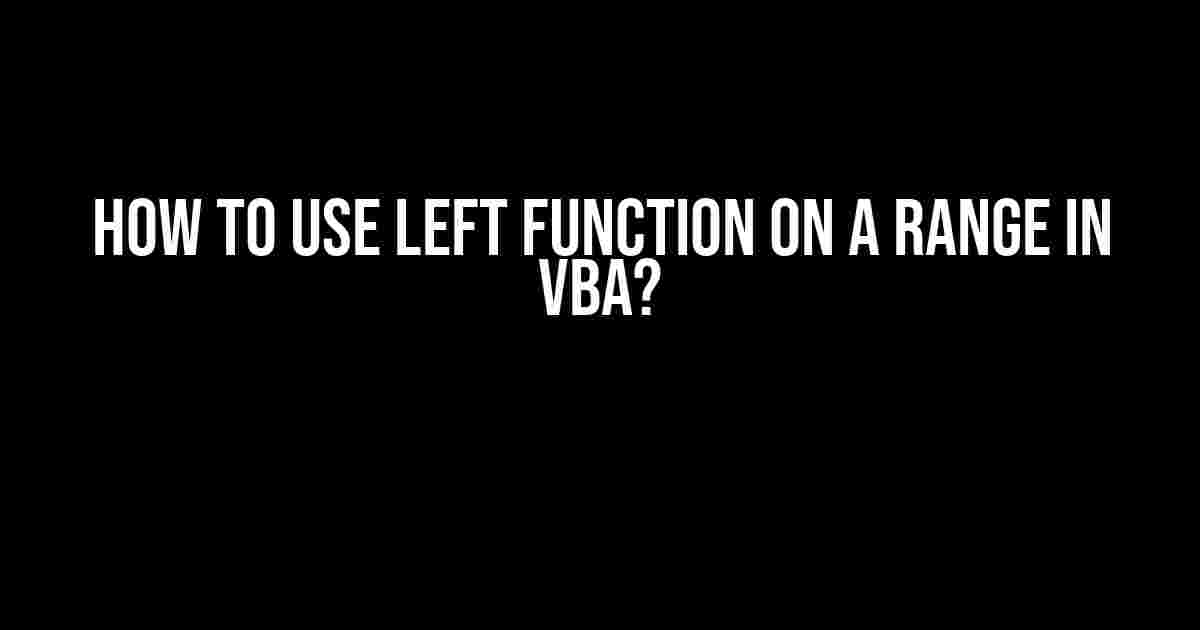Introduction
When working with strings in VBA, it’s common to need to extract a portion of the string. The Left function is a powerful tool that allows you to do just that, but how do you use it on a range of cells?
The Left Function
The Left function in VBA takes two arguments: the string you want to extract from, and the number of characters you want to extract from the left. The syntax for the Left function is:
Left(string, length)
Using Left on a Range
To use the Left function on a range of cells, you need to iterate over the cells in the range and apply the Left function to each cell individually. Here’s an example of how you can do this:
Sub UseLeftOnRange()
Dim rng As Range
Dim cell As Range
Set rng = Range("A1:A10") ' change this to your range
For Each cell In rng
cell.Value = Left(cell.Value, 5) ' extracts the left 5 characters
Next cell
End Sub
Alternative: Using Array Formula
Alternatively, you can use an array formula to apply the Left function to an entire range at once. Here’s an example:
=LEFT(A1:A10, 5)
Note that this formula will return an array of values, so you’ll need to array-enter it (press Ctrl+Shift+Enter instead of just Enter) for it to work.
Conclusion
Using the Left function on a range in VBA is a simple but powerful technique that can be used to extract and manipulate strings in your Excel worksheets. Whether you choose to use a VBA loop or an array formula, the Left function is an essential tool to have in your toolkit.
Frequently Asked Question
Get ready to master the art of using Left on a range in VBA!
What is the Left function, and how does it work in VBA?
The Left function in VBA is used to extract a specified number of characters from the left side of a string. It takes two arguments: the string you want to extract from, and the number of characters you want to extract. For example, Left(“Hello, World!”, 5) would return “Hello”. In the context of a range, you can use the Left function to extract a certain number of characters from the left side of each cell in the range.
How do I use the Left function on a range in VBA?
To use the Left function on a range in VBA, you can use the following syntax: `Range(“A1:A10”).Value = WorksheetFunction.Left(Range(“A1:A10”).Value, 5)`. This will extract the left 5 characters from each cell in the range A1:A10 and return the result as an array.
Can I use the Left function on a entire column or row in VBA?
Yes, you can use the Left function on an entire column or row in VBA. For example, `Range(“A:A”).Value = WorksheetFunction.Left(Range(“A:A”).Value, 5)` will extract the left 5 characters from each cell in column A. Similarly, `Range(“1:1”).Value = WorksheetFunction.Left(Range(“1:1”).Value, 5)` will extract the left 5 characters from each cell in row 1.
How do I apply the Left function to a range of cells without hardcoding the range?
You can apply the Left function to a range of cells without hardcoding the range by using variables to define the range. For example, `Dim myRange As Range: Set myRange = Range(“A” & Rows.Count).End(xlUp).Resize(10, 1): myRange.Value = WorksheetFunction.Left(myRange.Value, 5)`. This will apply the Left function to the range of 10 cells starting from the last row with data in column A.
What are some common use cases for using the Left function on a range in VBA?
Some common use cases for using the Left function on a range in VBA include extracting prefixes or suffixes from a column of strings, removing unwanted characters from a range of cells, and creating a new column with a subset of characters from an existing column.

